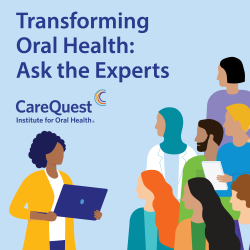Enter your email to receive the CareQuest newsletter:
June 11, 2024
By Wai-Sum Leung, MS, RDH, and Stephanie Clester, MA, RDH
As dental professionals and health care providers, we should recognize that every patient is unique in their care needs and will have specialized, unequal, treatment plans. In other words, dental clinics should promote health equity.

What is health equity? Oral health equity ensures that all individuals have fair and just access to oral health care regardless of their race, ethnicity, geographic location, socio-economic status, and numerous other social drivers of health that impact how individuals can access oral health care. But health equity is not the same as health equality. Health equality refers to a state where everyone is provided the same opportunities, care, and services.
So, promoting health equity in your dental clinic means recognizing that different patients, staff, and communities all have unique needs and may not benefit from getting equal treatment. Thus, the actions you take and the resources you provide may not be equal, but they are instruments of equity all the same. For example, equal treatment would be to provide translation services for all your patients regardless of their needs. However, providing translation services for patients who do not speak English or are hearing impaired is equitable.
Recognizing Patients’ Barriers to Care, Health Disparities, and Cultural Differences
In addition to understanding what health equity means, recognizing privilege will also provide an opportunity to identify gaps in care. But it is much easier to identify gaps that you have personally experienced rather than the disadvantages that some of your patients face. Ask yourself some questions to identify those privileges:
- Do I have a home?
- Am I worried that I won’t be able to eat dinner tonight?
- Am I worried about transportation?

Your answers and those of your patients could be very different.
Now that you are aware of your privileges, evaluate how your dental clinic may be able to help patients who do not have that same privilege. Is there something you can modify in your dental clinic workflow that would make care more accessible for patients who encounter barriers such as finances, transportation, location, or language?
Additionally, health disparities related to racial, ethnic, and socioeconomic backgrounds are prominent issues in our health care system. Overcoming these barriers begins with recognizing what you don’t already know. In a setting of working with diverse groups of patients, it is best to practice cultural humility — being open-minded and understanding that just because other’s ways are not your ways does not make them wrong.
Sometimes you might be uncomfortable asking about cultural differences because you are afraid of offending a patient, but in our experience, most people appreciate the attempt to respect preferences and improve communications. Let patients know why you are asking these questions. You can simply say, “Our organization is trying to enhance its cultural awareness and learn more about you and your needs.”
Asking about language preferences is usually an easy and comfortable way to jump into cultural discussions as well. Be sure to provide literature on health education materials targeted and tailored to the diverse populations you serve. Take the time to build relationships with your patients and make the effort to learn some simple phrases in their language; saying, “Hello,” and “Thank you,” in a patient’s preferred language goes a long way to show you care.

By valuing diversity and acquiring cultural knowledge, you send a message of awareness and sensitivity. Intercultural communication requires understanding attitudes and perceptions of personal space, physical gestures, eye contact, and communication styles that lead to improved communication and trust. When you have a clearer picture of the patients and integrate cultural humility, you build an appreciation for differences in worldviews to better understand perceptions of dental-related illnesses as well as insights into how health decisions are made.
Our work at CareQuest Institute is grounded in health equity. From the education we provide to the research we do to the community organizations that we fund, we aim to dismantle unjust structures and systems that drive entrenched disparities. We invite you to learn more about our work and explore past webinars that focused on various aspects of health equity.
Editor’s Note:
Wai-Sum Leung, MS, RDH, was born in Hong Kong and immigrated to the United States as a young child. Her experience in life has been significantly influenced and shaped by her identity as a person of color and an immigrant with English as a second language. She has had to balance the two cultures she grew up with and witness the struggles of her family navigating the US health care system with limited English proficiency. She is a project coordinator at CareQuest Institute, working to increase oral health access for disadvantaged and underserved populations. Her lived and professional experience drives her passion to promote health equity of all.
Stephanie Clester, RDH, MA, serves as a clinical content and support specialist for CareQuest Institute. In this role, she focuses on utilizing research-supported and data-driven decisions to enhance educational projects aimed at supporting dental public health improvement programs, particularly in value-based care (VBC). With more than 30 years of experience in dentistry, Clester’s background includes clinical dental hygiene practice, VBC coaching, and a tenured position as a dental hygiene professor with a focus on health equity in public health, ethics, and health policy and advocacy courses.